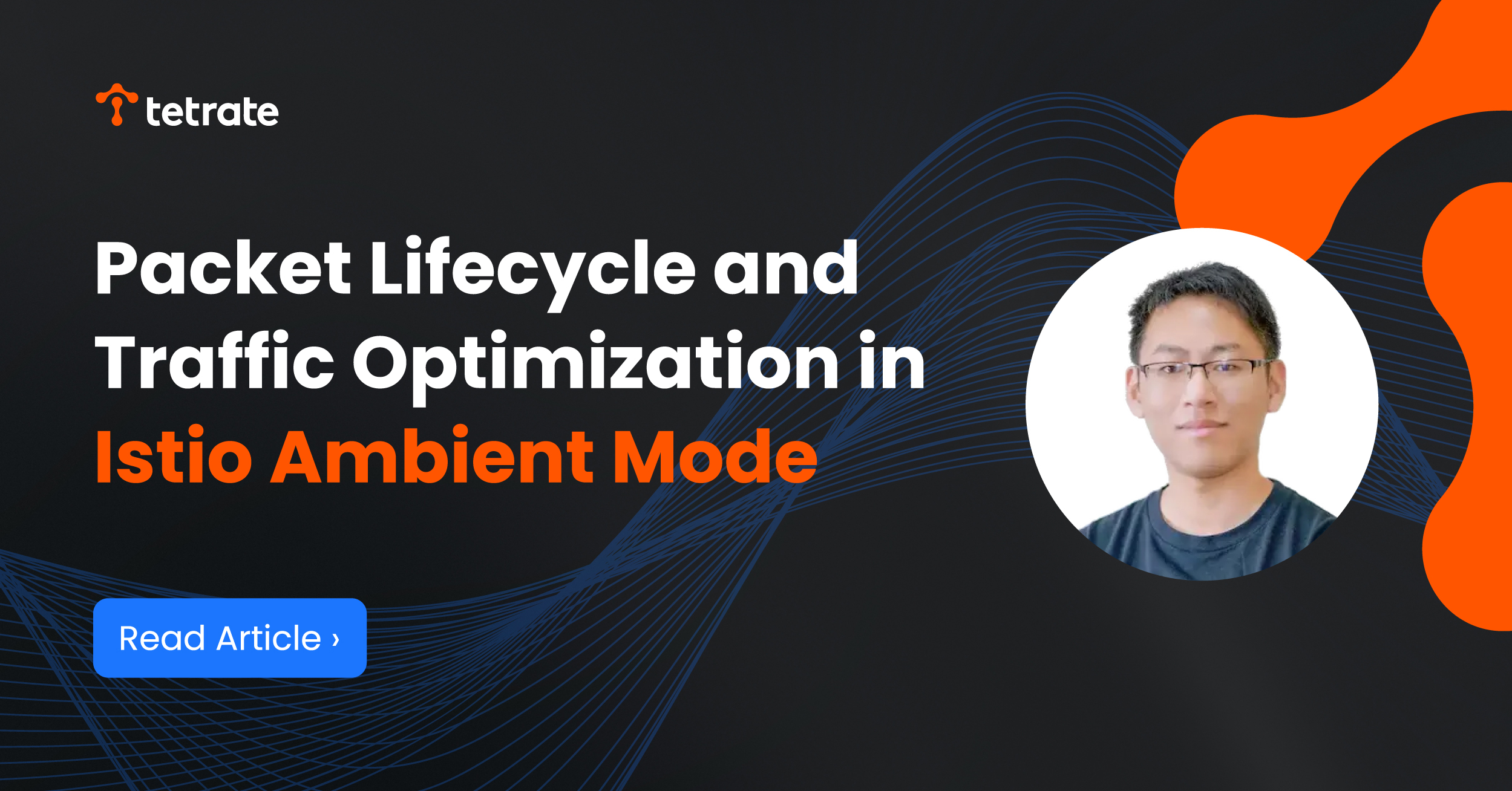Packet Lifecycle and Traffic Optimization in Istio Ambient Mode
This article provides an in-depth analysis of the packet lifecycle in Istio Ambient Mode. It covers everything from the interception and target resolu

This article provides an in-depth analysis of the packet lifecycle in Istio Ambient Mode. It covers everything from the interception and target resolution of initial packets to the fast forwarding and optimization strategies for subsequent packets, helping readers better understand the technical logic and performance practices behind Ambient Mode.
Tetrate offers an enterprise-ready, 100% upstream distribution of Istio, Tetrate Istio Subscription (TIS). TIS is the easiest way to get started with Istio for production use cases. TIS+, a hosted Day 2 operations solution for Istio, adds a global service registry, unified Istio metrics dashboard, and self-service troubleshooting.
Overview of Packet Lifecycle: From Kernel Space to User Space
In Ambient Mode, packet processing starts in the kernel space network stack of a Pod, where packets are intercepted by iptables rules and then processed by zTunnel in user space. zTunnel handles tasks such as transparent proxying, policy enforcement, and encrypted tunnel creation. Packets are then sent back to the kernel space network for forwarding to the target service or another zTunnel. The core idea is to analyze and tag the first packet in detail to pave the way for subsequent packets, thereby reducing redundant overhead.
The diagram below illustrates the packet lifecycle from a Pod to zTunnel in Istio Ambient Mode.
The following sections will detail the processing paths for both the first packet and subsequent packets, analyzing the technical highlights and optimization strategies.
First Packet Path: From Interception to Destination Resolution
Initial Packet Emission
When an application in a Pod emits a packet (e.g., an HTTP request), the packet is first processed by the Pod’s network namespace and kernel space network stack.
Transparent Interception via Iptables
iptables rules filter outbound traffic. If the destination address is non-local and the packet lacks specific tags, it is redirected to zTunnel’s transparent proxy port (e.g., 15006 or 15008). Using IP_TRANSPARENT and SO_ORIGINAL_DST options, zTunnel can extract the packet’s original destination address in user space. This ensures transparent proxying for services located on the same node, across nodes, or outside the mesh.
Policy Validation and Processing in zTunnel User Space
Once in zTunnel, the first packet undergoes policy and security checks such as RBAC validation and mTLS encryption determination. For in-mesh traffic, an HTTP/2 CONNECT tunnel (HBONE) is established for encrypted cross-node communication. For out-of-mesh traffic, direct TCP transmission is used.
Packet Egress and Connection Establishment
After processing, zTunnel establishes an outbound socket (e.g., HTTP/2 tunnel or plaintext TCP connection) based on the packet’s parsed details, sends it back to the kernel space, and routes it to the target service or zTunnel.
At this point, the first packet has completed a full journey from kernel space to user space and back. Connection states, policies, and tunnel information are recorded to optimize subsequent packets.
Subsequent Packet Path: Fast Forwarding with Conntrack and Tunnel Reuse
Once the first packet completes destination resolution and policy validation, the Linux kernel’s connection tracking (conntrack) records the connection state and tags it. Subsequent packets belonging to the same connection bypass complex iptables redirection and destination resolution, directly reaching zTunnel’s inbound socket.
Role of Conntrack
conntrack tracks existing connections, providing a fast path for subsequent packets. This allows packets to be forwarded directly to zTunnel without repeatedly triggering iptables rules or undergoing policy checks.
Inbound Socket and User Space Processing
Subsequent packets entering zTunnel’s inbound socket are directly identified by connection tags, skipping complex RBAC validation or encryption decisions. If an encrypted tunnel (HBONE) was established for the first packet, subsequent packets reuse this tunnel. For plaintext traffic, the existing TCP connection is used for direct transmission.
Optimization for Tunnel and Plaintext Paths
- HBONE Tunnel: For in-mesh encrypted traffic, HTTP/2 tunnels enable multiplexing, reducing repeated connection overhead.
- Plaintext Socket: For local or external unencrypted traffic, subsequent packets use the existing plaintext connection, avoiding extra encapsulation.
These mechanisms greatly simplify the processing path for subsequent packets, improving performance and throughput.
Key Technical Points and Optimization Strategies
- Transparent Proxying: Using IP_TRANSPARENT and SO_ORIGINAL_DST, zTunnel seamlessly captures and parses non-local traffic, achieving true transparent proxying.
- Efficient Kernel-User Space Switching: By completing detailed parsing and policy validation for the first packet in user space, and leveraging conntrack and inbound socket mechanisms for subsequent packets, unnecessary context switching is minimized.
- Multiplexed Tunnels: HTTP/2 CONNECT tunnels (HBONE) support encryption, load balancing, and multiplexing, enhancing efficiency for subsequent packet forwarding.
Practical Recommendations and Considerations
- Multi-Platform Adaptation: Transparent proxying relies on Linux features. For non-Linux platforms (e.g., Windows, macOS), local proxies or alternative solutions may be required.
- Tuning and Observability: Use zTunnel logs, connection tracking, and mesh observability tools to monitor traffic paths and performance. Fine-tune iptables rules, RBAC policies, and tunnel parameters based on data and results.
Conclusion
Istio Ambient Mode introduces innovative designs for packet lifecycle and traffic optimization. By performing comprehensive policy parsing and encryption negotiation for the first packet, and leveraging conntrack for fast forwarding of subsequent packets, Ambient Mode strikes a balance between transparent proxying, scalability, and performance.
As the core component of Ambient Mode, zTunnel combines transparent application experience with underlying network optimization, meeting service mesh security and policy requirements while significantly reducing redundant overhead. This makes traffic processing more efficient and seamless.










